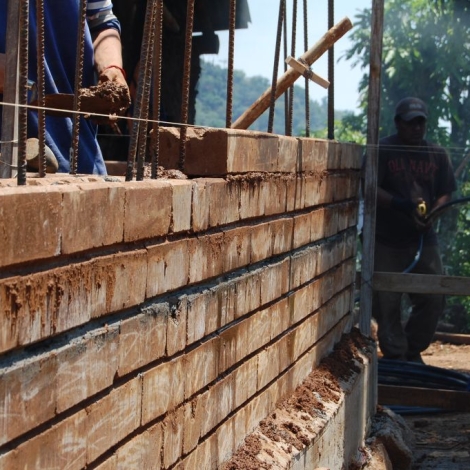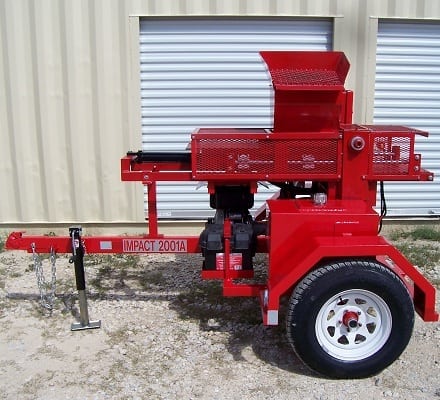Building with compressed-earth blocks makes sense, and not just because most of the construction materials are right under our feet. Earthen walls regulate temperatures, dampen sound, repel mold and, with the right build, they can resist earthquakes, fires and other disasters.
[For more on earth building solutions, please see our Q&A with Jim Hallock.]
We had heard that earthen blocks have another advantage, too, that building with them is simple. With the right blocks, building a wall can be like stacking huge Legos. To find out if that’s really the case, we turned to the earthen construction and earth building solutions expert Adam De Jong. Adam co-founded Dwell Earth, an earthen construction firm that works with both non-profits and businesses to create functional and beautiful buildings around the world.
Dwell Earth trains organizations and communities in block making, offers design guidance and then leads them through the construction process. The company helped the machinery manufacturer Vermeer design a block press that churns out easy-to-stack interlocking bricks. With these bricks, even novice builders can erect tough, straight walls with only a little training.
There is a village near Ciudad Barrios in the mountains of eastern El Salvador where a Dwell Earth crew taught families to build their own homes. It was a sweat-equity program in which the residents worked alongside Dwell Earth’s consultants. Using pictures of key stages of the process, Adam guided us through the construction of the walls up to the roof. We’ll run a how-to guide on roof construction in a later installment.
This is how to build a two-room home from compressed-earth blocks. See an animation of this build on YouTube. For up-to-date videos and animated construction guides, please see Dwell Earth’s YouTube channel. And follow the company on Facebook for updates on its earth building solutions worldwide.

Start by testing the soil to determine attributes such as clay content. In this build, the soil had a lot of clay, so the builders mixed in some sand. Then add six to 10 percent Portland cement to weather proof the block before pressing (top left). Community members follow a pictorial guide (upper right), and we have provided a version of that in the link through the image at the top of this page. And the bricks cured for one week while wrapped in plastic and banana leaves to preserve their moisture (bottom).

Dig a foundation trench. This is an earthquake-prone area, so the foundation is deeper, at about three feet (one meter). It is filled with a layer of volcanic ash as a footer, with rock bound with concrete on top of that. Rebar set vertically in the foundation ties into the horizontal eight-inch beam shown on top. The guide strings help ensure that it is level.

A concrete layer locks in the rebar beam, which is now covered and not visible, and the vertical rebar pictured.

Tie in corners, windows, doors and inner walls.

In low-seismic areas, dry-stacking the blocks without mortar is possible, but on this build in El Salvador, the rows of blocks sandwich a slurry made of the same dirt, sand and cement mixture of which the blocks are made. Every fifth row is mortared with cement.

Novice block layers can quickly learn to build straight, level walls.

Here you can see a gray line of cement between two rows of blocks.

Going up…

The arrow above points to a J bolt embedded between two rows of blocks. It will anchor the door frame.

Electrical outlets can be cut out of the blocks as shown. The three pictures of sand-colored blocks are from another build, shown here as an illustration.

Here you can see the walls of the covered porch and the two doorways into the home. The walls are nearly finished.

Here is the home nearly finished with a laminate roof and a partial coat of paint.

For an idea of how fancy you can get with earthen construction and earth building solutions, here is the Blessman Ministries Lodge of Dreams in Limpopo, South Africa, designed and built by Dwell Earth. Photo by Jacob Sharp.



Amazing and really helpful. I wonder what consistency the soil has. If it does have a certain consistency, would hay be helpful for this method?
May be another and simple way to build a bouse of mud blocks. First to reduce the high cost. 2nd to be available for living. 3rd if possible to have a clay blocks.
I need to study more about this clay Interlocking brick/blocks pratically,where can i find more Tips on how you can do once you rearch the last row for renter,
How can i do the finish with out loose the breathing property of the ceb block? thanks
Interested in teaching the wisdom of this approach.
Wanting to find a way to build a house with interlocking blocks that does not require mortar. It needs to be most cost effective , (to be done in philippines), it needs to be able to withstand strong strong winds, storms, and earthquakes. I have read about Habiterra but their machine to make the blocks cost $7,500. I am searching for something that can do the same job with much less initial cost. It needs to be a good idea and option. Plus, to have the machine you have to buy it from Habiterra.
yours,
Irving Everson
Hello EveryonE,
There are lots of great questions here. I think you will all find great benefit in our new website (www.dwellearth.com) where you can learn and explore compressed earth block production and construction with several different types of Compressed earth block machines. We also offer great opportunities for hands on learning. everything about soil science, mix design, compressed earth block production, construction techniques and wall finishes are all covered in one awesome training event. Check out (https://earthblocktraining.splashthat.com/) for details about the earth block training and to sign up.
how many blocks did you use for the construction of the house ?
I wonder why they did not make the pillars, in front of the house, with the same blocks.
Do you have any information regarding the costing of rammed earth building . Eg ball park figure for a two story building that consists of 3 large sized rooms plus male , female and disabled bathrooms upper and lower levels?
I am currently doing a project on low-cost housing in hilly regions of Nepal and this article has provided me with a great insight on utilization of local resources. Thank you.
Hello Rob
God bless you. Always
You finish with a lime render. This maintains the breathability of the walls.
https://dwellearth.com/
HI
i am very interested in ceb but am trying to find ways to build without or as little cement as possible .i am also interested in how to make a two story house as well i was told you need steel to do this .i am just learning of the methods and the different brick styles that are used and trying to figure out what is best for my needs.i am also wondering about the rh factors of he brick .sory it may not be called rh factor the ability to keep it warm and or cold . thank for anyones help
Not a geologist myself, but I think the consistency should be such that it has enough sand for compressibility and enough fine clay for adhesiveness.
has this building method being introduced to Nigeria yet?
I think creating more prominent interlocking protrusions.Might negate the need for rebars.
I need to construct but wear I can buy mud block meacin in banglore